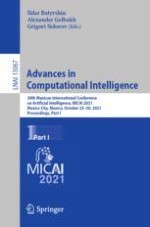2021 | Book
Advances in Computational Intelligence
20th Mexican International Conference on Artificial Intelligence, MICAI 2021, Mexico City, Mexico, October 25–30, 2021, Proceedings, Part I
Editors: Dr. Ildar Batyrshin, Alexander Gelbukh, Prof. Dr. Grigori Sidorov
Publisher: Springer International Publishing
Book Series : Lecture Notes in Computer Science
